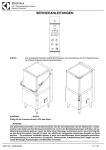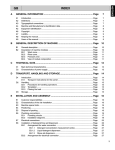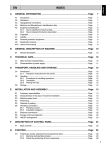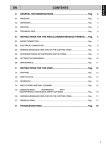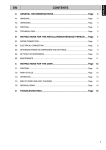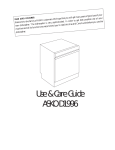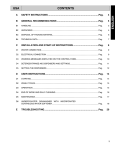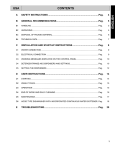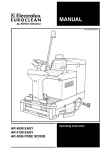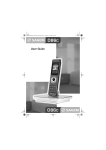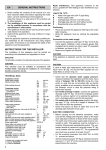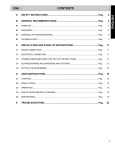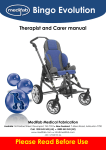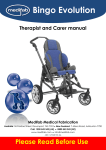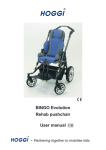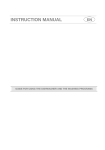Download ENGLISH EN INDEX
Transcript
A
GENERAL INFORMATION .............................................................................. Pag.
7
A1
A2
A3
A4
A5
7
7
7
8
8
8
8
8
8
9
9
9
A6
A7
A8
A9
A10
B
C
D
10
B1
10
General description ......................................................................................................... Pag.
TECHNICAL DATA ........................................................................................... Pag.
10
C1
C2
10
11
Main technical characteristics.......................................................................................... Pag.
Characteristics of power supply....................................................................................... Pag.
TRANSPORT, HANDLING AND STORAGE.................................................... Pag.
12
D1
12
12
12
12
12
12
12
D3
Introduction...................................................................................................................... Pag.
D1.1 Transport: Instructions for the carrier................................................................... Pag.
Handling .......................................................................................................................... Pag.
D2.1 Procedures for handling operations..................................................................... Pag.
D2.2 Translation ........................................................................................................... Pag.
D2.3 Placing the load ................................................................................................... Pag.
Storage ............................................................................................................................ Pag.
INSTALLATION AND ASSEMBLY ................................................................... Pag.
13
E1
E2
E3
E4
E5
E6
13
13
13
13
14
14
14
15
18
18
18
E7
E8
E9
F
Introduction ...................................................................................................................... Pag.
Definitions........................................................................................................................ Pag.
Typographical conventions .............................................................................................. Pag.
Machine and Manufacturer’s identification data............................................................... Pag.
Equipment identification .................................................................................................. Pag.
A5.1 How to identify the technical data........................................................................ Pag.
A5.2 How to interpret the factory description............................................................... Pag.
Copyright ......................................................................................................................... Pag.
Liability............................................................................................................................. Pag.
Personal protection equipment ........................................................................................ Pag.
Keeping the manual......................................................................................................... Pag.
Users of the manual ........................................................................................................ Pag.
GENERAL DESCRIPTION OF MACHINE ....................................................... Pag.
D2
E
INDEX
Customer responsibilities ................................................................................................ Pag.
Characteristics of the place of machine installation......................................................... Pag.
Machine space limits ....................................................................................................... Pag.
Positioning ....................................................................................................................... Pag.
Disposal of packing ......................................................................................................... Pag.
Plumbing connections ..................................................................................................... Pag.
E6.1 Plumbing circuits ................................................................................................. Pag.
E6.2 Installation diagrams............................................................................................ Pag.
Electrical connections...................................................................................................... Pag.
Energy control arrangement ............................................................................................ Pag.
HACCP arrangement....................................................................................................... Pag.
DESCRIPTION OF CONTROL PANEL ............................................................ Pag.
19
F1
20
Basic controls .................................................................................................................. Pag.
ENGLISH
EN
3
G
STARTING.........................................................................................................Pag.
21
G1
21
21
21
21
21
21
21
22
G2
G3
G4
H
GENERAL SAFETY RULES.............................................................................Pag.
25
H1
25
25
25
25
25
25
26
26
H2
H3
H4
H5
I
Introduction ......................................................................................................................Pag.
H1.1 Protection devices installed on the machine........................................................Pag.
H1.1.1 Guards ..............................................................................................Pag.
H1.2 Safety signs to be displayed on the machine or near the work area ...................Pag.
Decommissioning ............................................................................................................Pag.
Instructions for use and maintenance ..............................................................................Pag.
Improper use....................................................................................................................Pag.
Residual risks ..................................................................................................................Pag.
NORMAL MACHINE USE.................................................................................Pag.
27
I1
I2
I3
I4
I5
I6
I7
I8
27
27
27
27
27
28
29
29
30
30
30
31
31
31
31
I9
I10
I11
I12
4
Preliminary checks, adjustments and operational tests ...................................................Pag.
G1.1 Electrical and plumbing checks ...........................................................................Pag.
G1.2 Check the positioning of tank components ..........................................................Pag.
G1.2.1 Check the fitting of filters and overflows ............................................Pag.
G1.2.2 Arm fitting check................................................................................Pag.
Starting ............................................................................................................................Pag.
Detergent/rinse-aid dispensers and settings ...................................................................Pag.
Setting the dispensers .....................................................................................................Pag.
Correct use ......................................................................................................................Pag.
Characteristics of personnel enabled to operate on the machine....................................Pag.
First use ...........................................................................................................................Pag.
Daily activation of machine ..............................................................................................Pag.
Wash cycles.....................................................................................................................Pag.
Operation .........................................................................................................................Pag.
Alarms .............................................................................................................................Pag.
Machine cleaning.............................................................................................................Pag.
I8.1
End of service and daily internal cleaning ...........................................................Pag.
I8.2
Exterior cleaning..................................................................................................Pag.
Long idle periods .............................................................................................................Pag.
Maintenance ....................................................................................................................Pag.
I10.1 Preventive maintenance ......................................................................................Pag.
Machine disposal .............................................................................................................Pag.
Troubleshooting ...............................................................................................................Pag.
EN
INDEX OF FIGURES AND TABLES
Figure 1
Reproduction of the marking/dataplate on the machine .................................................... Pag.
8
Figure 2
Position of marking............................................................................................................. Pag.
8
Figure 3
Technical data identification ............................................................................................... Pag.
8
Figure 4
Example of document identification data. .......................................................................... Pag.
8
Figure 5
Unpacking .......................................................................................................................... Pag.
13
Figure 6
Machine positioning ........................................................................................................... Pag.
13
Figure 7
Removing the film .............................................................................................................. Pag.
13
Figure 8
Feet adjustment ................................................................................................................. Pag.
13
Figure 9
Machine fixing clamp.......................................................................................................... Pag.
14
Figure 10 Feed pipe connection......................................................................................................... Pag.
14
Figure 11 208V 3ph o 240V 3ph ........................................................................................................ Pag.
18
Figure 12 Energy control .................................................................................................................... Pag.
18
Figure 13 HACCP connection position............................................................................................... Pag.
18
Figure 14 Filters and overflow ............................................................................................................ Pag.
21
Figure 15 Wash and rinse arms ......................................................................................................... Pag.
21
Figure 16 Automatic dispenser arrangement ..................................................................................... Pag.
22
Figure 17 Detergent dispenser terminal block.................................................................................... Pag.
22
Figure 18 Rinse aid dispenser terminal block .................................................................................... Pag.
22
Figure 19 Automatic hood opening/closing ........................................................................................ Pag.
28
Figure 20 YELLOW rack..................................................................................................................... Pag.
29
Figure 21 GREEN rack....................................................................................................................... Pag.
29
Figure 22 BLUE rack for glasses........................................................................................................ Pag.
29
Figure 23 YELLOW container for cutlery............................................................................................ Pag.
29
Figure 24 Filters and overflow ............................................................................................................ Pag.
30
Figure 25 Wash and rinse arms ......................................................................................................... Pag.
30
ENGLISH
INDEX OF FIGURES
INDEX OF TABLES
Table 1
Main technical characteristics, performance and consumption.......................................... Pag.
10
Table 2
Control panel...................................................................................................................... Pag.
19
Table 3
Residual risks..................................................................................................................... Pag.
26
5
Foreword
The instruction manual (hereinafter Manual) provides the operator with useful information for working correctly and
safely, facilitating him in using the machine (hereinafter “machine”, “dishwasher” or “equipment”).
The following must not be considered a long and exacting list of warnings, but rather a set of instructions suitable for
improving machine performance in every respect and, above all, preventing injury to persons and animals and damage
to property due to improper operating procedures.
All persons involved in machine transport, installation, starting, use and maintenance, repair and dismantling must consult and carefully read this manual before performing the various operations, for the purpose of avoiding wrong and
improper actions that could negatively affect the machine’s integrity or endanger persons.
The manual must always be available to operators and carefully kept in the place where the machine is used so that it is
immediately at hand for consultation in case of doubts or whenever required.
If, after reading this manual, there are still doubts regarding machine use, do not hesitate to contact the Manufacturer, or
the authorized assistance centre, to receive prompt and precise assistance for better operation and maximum efficiency
of the machine.
During all phases of machine use, always respect the current regulations on safety, work hygiene and environmental
protection. It is the user’s responsibility to make sure the machine is started and operated only in optimal safety conditions for persons, animals and property.
This appliance is not intended for use by people (including children) with limited physical, sensory or mental abilities or
without experience and knowledge of it, unless they are supervised or instructed in its use by a person responsible for
their safety.
Children must be supervised to make sure they do not play with the equipment.
SAFETY INSTRUCTIONS
To reduce the risk of fire, electrical shock, or injury when using your dishwasher, please follow these basic precautions including the following:
• Read all instructions before using your dishwasher.
• This Manual does not cover every possible condition and situation that may occur. Use common sense and caution
when installing, operating and maintaining this appliance.
• Do not sit, stand or lean on the hood or racks of a dishwasher.
• Store dishwasher detergent and rinse agents in clearly marked packages with MSDS (Material Safety Data Sheets)
sheets in a safe place.
• FOR YOUR SAFETY DO NOT STORE OR USE GASOLINE OR OTHER FLAMMABLE VAPORS AND LIQUID IN
THE VICINITY OF THIS OR ANY OTHER APPLIANCE.
• Your dishwasher uses hot water to clean and sanitize a variety of wares. Machine surfaces and wares become hot
during and immediately following normal operations. Operators should use caution when loading and unloading
wares from the machine.
• Do not touch the heating element during or immediately after use.
• The installation of this unit must conform to local codes or, in the absence of local codes, to all National Codes governing plumbing, sanitation, safety and good trade practices.
• BEFORE SERVICING, DISCONNECT THE ELECTRICAL SERVICE AND PLACE A RED TAG AT THE DISCONNECT SWITCH TO INDICATE WORK IS BEING DONE ON THAT CIRCUIT.
• NOTICE: CONTACT YOUR AUTHORIZED SERVICE COMPANY TO PERFORM MAINTENANCE AND REPAIRS.
• NOTICE: Using any parts other than genuine factory manufactured parts relieves the manufacturer of all warranty
and liability.
• NOTICE: Manufacturer reserves the right to change specifications at any time without notice.
• WARNING: The equipment warranty is not valid unless the appliance is installed, started and demonstrated under
the supervision of a factory trained installer.
• WARNING: The unit must be installed by Personnel who are qualified to work with electricity and plumbing. Improper
installation can cause injury to personnel and/or damage to the equipment. The unit must be installed in accordance
with applicable codes.
SAVE THESE INSTRUCTIONS
6
A1
GENERAL INFORMATION
Introduction
This chapter describes the symbols used (that mark and
identify the type of warning) and gives the definitions of
terms used in the manual, responsibilities and copyright.
A2
Definitions
Listed below are the definitions of the main terms used
in the Manual. Carefully read them before using the
Manual.
Operator
an operator who carries out machine installation, adjustment, use, maintenance, cleaning, repair and transport.
Manufacturer
Electrolux Professional S.p.A. or any other assistance
centre authorized by Electrolux Professional S.p.A..
Operator qualified for normal machine use
an operator who has been informed, instructed and
trained regarding the tasks and hazards involved in normal machine use.
Specialized technician or Technical assistance
an operator instructed/trained by the Manufacturer and
who, based on his professional and specific training,
experience and knowledge of the accident-prevention
regulations, is able to appraise the operations to be carried out on the machine and recognize and prevent possible risks. His professionalism covers the mechanical,
electrotechnical and electronics fields.
Danger
source of possible injury or harm to health.
Hazardous situation
any situation where an operator is exposed to one or
more hazards.
Risk
a combination of probabilities and risks of injury or harm
to health in a hazardous situation.
Guards
safety measures consisting of the use of specific technical means (guards and safety devices) for protecting
operators against dangers.
Guard
an element of a machine used specifically to provide
protection by means of a physical barrier.
Emergency stop device
a group of components intended for the emergency stop
function; the device is activated with a single action and
prevents or reduces damage to persons/machines/property/animals.
Electrocution
an accidental discharge of electric current on a human
body.
A3
Typographical conventions
For best use of the manual, and therefore the machine, it
is advisable to have good knowledge of the terms and
typographical conventions used in the documentation.
The following symbols are used in the manual to mark
and identify the various types of hazards:
WARNING!
DANGER FOR THE HEALTH AND SAFETY
OF OPERATORS.
WARNING!
DANGER OF ELECTROCUTION - DANGEROUS VOLTAGE.
Machine guards and protection devices marked with this
symbol must only be opened by qualified personnel,
after disconnecting the power to the machine.
WARNING!
DANGER OF DAMAGE TO THE MACHINE.
IMPORTANT
Before servicing, disconnect the electrical main
switches and place a red tag at the disconnect
switch to indicate work is being done on that circuit.
Words and safety warnings further explaining the type of
hazard are placed next to the symbols in the text. The
warnings are intended to guarantee the safety of personnel and prevent damage to the machine or the product
being worked.
The drawings and diagrams given in the manual are not
in scale. They supplement the written information with an
outline, but are not intended to be a detailed representation of the machine supplied.
The numerical values given in the machine installation
diagrams refer to measurements expressed in mm (see
pargraph E6.2 “Installation diagrams”).
Safety device
a device (other than a guard) that eliminates or reduces
the risk; it can be used alone or in combination with a
guard.
Customer
the person who purchased the machine and/or who
manages and uses it (e.g. company, entrepreneur, firm).
7
ENGLISH
A
Machine and Manufacturer’s identification data
A4
.
A reproduction of the marking or dataplate on the
machine is given below.
F.Mod.
PNC
EL
F.Mod. EHT8IG4
2012
Comm. Model
EHT8IG4
Ser.Nr. 22006001
50 Hz
Max
12.9 kW
Default
9.9 kW
EHT8IG4
9CGX 504263 00
AC 208V 3
Electrolux Professional spa - Viale Treviso, 15
IP25
Electrolux Professional spa - Viale Treviso, 15 - 33170 Pordenone (Italy)
Figure 1 Reproduction of the marking/dataplate
on the machine
C1 Main technical characteristics
MODEL
The dataplate gives the product identification and technical data; the meaning of the information given on it is
listed below.
F.Mod.....................
factory description of the product
Comm. Model ........
trade description
PNC.......................
production code number
Ser. Nr. .................
serial number
AC 208V 3 .............
power supply voltage
60 Hz .....................
power supply frequency
Max 12.9 kW .........
max. power absorbed
Default 9.9 kW.......
power absorbed as factory setting
2012 ......................
year of construction
IP25 .......................
protection rating
Electric
Power supply voltage
V
240 3
Frequency
Hz
60
Figure 3 Technical data identification
A5.2
How to interpret the factory description
The factory description on the dataplate has the following meaning (some examples are given below):
Double-skin hood version
(1)
(2)
(3)
(4)
(5)
(6)
(7)
(8)
(9)
E
E
HT
HT
8
8
I
T
L
I
G
E
8
L
G
4
Variables description
Electrolux Professional spa - Viale Treviso, 15 -33170
Pordenone (Italy).....
EHT8IG4
Power supply
Manufacturer
(1) Mark
E = Electrolux
(2) Machine type
HT = Hood type
(3) Racks/h
8 = capacity 80 racks/h
(4).. (9)
T = automatic, I = double-skin hood, E = Energy
Saving Device, L = De-lime cycle, G = Detergent pump
+ rinse aid pump + drain pump, 4 = 240V, 8 = 208V.
The marking plate is located on the right side panel of
the equipment.
A6
F.Mod.
PNC
EL
EHT8IG4
9CGX 504263 00
AC 208V 3
2012
Comm. Model
EHT8IG4
Ser.Nr. 22006001
50 Hz
Max
12.9 kW
Default
9.9 kW
Copyright
This manual is intended for consultation only by the
operator and can be given to third parties only with the
written permission of Electrolux Professional S.p.A..
IP25
Electrolux Professional spa - Viale Treviso, 15 - 33170 Pordenone (Italy)
A7
Figure 2 Position of marking
A5
A5.1
DOC. NO.
Equipment identification
How to identify the technical data
To identify the technical data (Figure 3) read the factory
description of the product (F.Mod.) on the dataplate,
identify the main machine data and consult the Table 1
“Main technical characteristics, performance and consumption”.
8
Liability
The instructions are updated to the month and year
given in the box located at the bottom right of the cover.
The edition corresponds to the manual revision number.
Every new edition replaces and cancels the previous
ones.
5956.6B2.01
EDITION: 1
12.2012
Number
Document
Edition
Month
Year
Figure 4 Example of document identification data.
The Manufacturer declines any liability for damage and
malfunctioning caused by:
non-compliance with the instructions contained in this
manual;
• repairs not carried out in a workmanlike fashion, and
replacements using spare parts different from those
specified in this manual (the fitting and use of nonoriginal spare parts and accessories can negatively
affect machine operation);
• operations by non-specialized technicians;
• unauthorized modifications or operations;
• inadequate maintenance;
• improper machine use;
• unexpected extraordinary events;
• use of the machine by uninformed and untrained personnel;
• non-application of the current provisions in the country of use, concerning safety, hygiene and health in
the workplace.
The Manufacturer declines any liability for damage
caused by arbitrary modifications and conversions carried out by the user or the Customer.
The employer or workplace manager is responsible for
identifying and choosing adequate and suitable personal
protection equipment to be worn by operators, in compliance with current regulations in the country of use.
Electrolux Professional S.p.A. declines any liability for
possible inaccuracies contained in the manual, if due to
printing or translation errors.
Any supplements to the instruction manual the Customer
receives from the Manufacturer must be kept together
with the manual, of which they will form an integral part.
A8
(1) Use heat resistant gloves suitable for contact with
water and the substances used (see the safety data
sheet of the substances used to check other possible
PPE).
Failure to use the personal protection equipment by operators, specialised technicians or users can involve exposure to chemical risk and possible damage to health.
A9
Keeping the manual
The manual must be carefully kept for the entire life of
the machine until decommissioning.
The manual must stay with the machine in case of transfer, sale, hire, granting of use or leasing.
A10
Users of the manual
This manual is intended for:
• the carrier and handling personnel;
• installation and start-up personnel;
• the employer of machine users and the workplace
manager;
• operators in charge of normal machine use;
• specialized technicians - technical assistance (see
wiring diagram and service manual).
Personal protection equipment
Give below is a summary table of the Personal Protection Equipment (PPE) to be used during the various
stages of the machine’s service life.
Protective
garments
Safety footwear
Gloves
C
M
F
Glasses
Safety
helmet
Stage
Transport
Handling
M
M
F
Unpacking
F
C
C
C
C
F
M
Assembly
F
M
F
Normal use
M
M
M (1)
F
F
M
C
C
F
M
M (1)
F
F
M
M (1)
F
Maintenance
F
M
F
Dismantling
F
M
F
Scrapping
F
M
F
C
C
C
Adjustments
Routine
cleaning
Extraordinary
cleaning
F
C
C
C
C
C
C
C
C
C
C
Key:
M
PPE REQUIRED
F
PPE AVAILABLE OR TO BE USED IF NECESSARY
C
PPE NOT REQUIRED
9
ENGLISH
•
B
B1
GENERAL DESCRIPTION OF MACHINE
General description
The dishwasher is suitable for washing dishes, glasses, cups, cutlery, trays, containers and receptacles in plastic and/or
steel used for preparing, cooking and serving; as well as various cooking utensils in ceramic and/or metal.
The machine is designed for the above-mentioned applications. Under no circumstances may the machine be used for
other applications or ways not provided for in this manual. This equipment has been produced to meet the needs for a
better work environment and economical efficiency. These dishwashers are used in restaurants, cafeterias, cooking centres and large institutions. The special dish racks, that can be equipped with various inserts, offer practical and easy use
for obtaining excellent washing results. The electronic system enables complete supervision of the washing process.
The control panel also has a display that shows the operating parameters and signals any anomalies.
Systems for scraping and wetting the dishes (e.g. manual prewash spray) and areas for sorting and arranging them in
the racks must be arranged ahead of the dishwasher.
C
C1
TECHNICAL DATA
Main technical characteristics
MODEL
EHT8ILG8/
EHT8IELG8
EHT8ILG4/
EHT8IELG4
EHT8TIELG8
EHT8TIELG4
240 3ph
Supply voltage:
V
208 3ph
240 3ph
208 3ph
Frequency
Hz
60
60
60
60
Max. power. absorbed
kW
12.9 (*)
12.9 (*)
12.9 (*)
12.9 (*)
power absorbed as factory setting
kW
9.9
9.9
9.9
9.9
Boiler heating elements
kW
9.0
9.0
9.0
9.0
Tank heating elements
kW
3.0
3.0
3.0
3.0
Water supply pressure
psi/ kPa
7.25-101/ 50-700
7.25-101/ 50-700
7.25-101/ 50-700
7.25-101/ 50-700
- for models without ESD
°F / °C
50-149 / 10-65
50-149 / 10-65
50-149 / 10-65
50-149 / 10-65
- for models with ESD
°F / °C
50-68 / 10-20
50-68 / 10-20
50-68 / 10-20
50-68 / 10-20
Water supply hardness
ppm/ °f
140 / 14 max
140 / 14 max
140 / 14 max
140 / 14 max
Electric conductivity of water
μS/in / μS/cm
< 1016 / < 400
< 1016 / < 400
< 1016 / < 400
< 1016 / < 400
Concentration of chlorides in water
ppm
< 20
< 20
< 20
< 20
Rinse cycle water consumption
gal / l
0.53 / 2.0
0.53 / 2.0
0.53 / 2.0
0.53 / 2.0
Boiler capacity
gal / l
3.17 / 12
3.17 / 12
3.17 / 12
3.17 / 12
Tank capacity
gal / l
6.34 / 24
6.34/ 24
6.34 / 24
6.34 / 24
Cycle duration in High Productivity mode ($)
sec.
45(***)-84-150
45(***)-84-150
45(***)-84-150
45(***)-84-150
Cycle duration in ETL-Sanitization mode ($)
sec.
57(***)-84-150
57(***)-84-150
57(***)-84-150
57(***)-84-150
Legal noise level Leq
dB(A)
<63
<63
<63
<63
Minimum Supply - Circuit Ampacity
amp
40
34
40
34
Water supply temperature:
Protection rating
IP25
IP25
IP25
IP25
lb [kg]
258 [117] / 331 [150] (&)
258 [117]/ 331 [150] (&)
335 [152]
335 [152]
Shipping weight
lb [kg]
284 [129]/ 364 [165] (&)
284 [129]/ 364 [165] (&)
370 [168]
370 [168]
Shipping width: - machine
- ESD
inch [mm]
32 1/4” [819] /
18 11/16” [475]
32 1/4” [819] /
18 11/16” [475]
32 1/4” [819] /
18 11/16” [475]
32 1/4” [819] /
18 11/16” [475]
Shipping height: - machine
- ESD
inch [mm]
68 1/8” [1730] /
37 [940]
68 1/8” [1730] /
37 [940]
68 1/8” [1730] /
37 [940]
68 1/8” [1730] /
37 [940]
Shipping depth: - machine
- ESD
inch [mm]
28 13/16” [732] /
29 1/8” [740]
28 13/16” [732] /
29 1/8” [740]
28 13/16” [732] /
29 1/8” [740]
28 13/16” [732] /
29 1/8” [740]
H07RN-F
Net weight
Power supply cable
H07RN-F
H07RN-F
H07RN-F
Supply cord diameter (min. - max. value)
inch [mm]
11/16” [18] - 1” [25]
11/16” [18] - 1” [25]
11/16” [18] - 1” [25]
11/16” [18] - 1” [25]
Latent heat without/ with ESD
kWh
0.5 / 0.35
0.5 / 0.35
0.5 / 0.35
0.5 / 0.35
Sensible heat without / with ESD
kWh
2/ 1.49
2/ 1.49
2/ 1.49
2/ 1.49
(*) = If activated by software, coincidence of tank and boiler heating elements. (***)= With water supply temperature at 149°F / 65°C.
($) = In models with energy saving device (ESD) cycle duration is extended by 11 seconds. (&)= with energy saving device (ESD).
Table 1 Main technical characteristics, performance and consumption
10
Standard cycle time may vary should the inlet water temperature be different from that indicated above.
Characteristics of power supply
The AC power supply to the machine must meet the following conditions:
• max. voltage variation ± 10%
• max. frequency variation ± 1% continuous ± 2% for a short period.
Harmonic distorsion, unbalanced three-phase supply voltage, voltage pulses, interruption, dips and the other electric
characteristics must respect the provisions of point 4.3.2 of Standard EN 60204-1 (IEC 60204-1).
IMPORTANT!
The machine’s power supply must be protected against overcurrents (short circuits and overloads) by
fuses or suitable thermal magnetic circuit breakers.
These must be fitted on an omnipolar disconnection system having a contact gap of at least 1/8” (3 mm).
IMPORTANT!
For protection against indirect contacts (depending on the type of supply provided for and connection
of earths to the equipotential protection circuit) refer to point 6.3.3 of EN 60204-1 (IEC 60204-1) with
the use of protection devices that ensure automatic cut-off of the supply in case of isolation fault in
the TN or TT systems or, for IT systems, the use of isolation controllers or differential current protection devices to activate automatic power disconnection (an isolation controller must be provided for
indicating a possible first earth fault of a live part, unless a protection device is supplied for switching
off the power in case of a such a fault. This device must activate an acoustic and/or visual signal
which must continue for the entire duration of the fault).
For example: in a TT system, a differential switch with cut-in current (e.g. 30 mA) coordinated with the
earthing system of the building where the machine is located must be installed ahead of the supply.
IMPORTANT!
Customers are requested to follow these instructions, otherwise the Manufacturer does not guarantee
the machine for continuous operation and/or against faults.
11
ENGLISH
C2
D
D1
TRANSPORT, HANDLING AND STORAGE
Introduction
Transport (i.e. transfer of the machine from one place to
another) and handling (i.e. transfer inside workplaces)
must occur with the use of special equipment of adequate capacity.
The machine must only be transported, handled and
stored by qualified personnel, who must have:
- specific technical training and experience;
- knowledge of the safety regulations and applicable
laws in the relevant sectors;
- knowledge of the general safety provisions;
- the ability to recognize and avoid any possible hazard.
D1.1
CAUTION!
For machine lifting, do not use movable
or weak parts such as casings, electrical
raceways, pneumatic parts, etc., as
anchoring points.
D2.2
D2.3
Transport: Instructions for the carrier
WARNING!
Do not stand under suspended loads
during the loading/unloading phases.
Unauthorized personnel must not access
the work zone.
IMPORTANT!
The machine’s weight alone is not sufficient to keep it steady.
The transported load can shift:
- when braking;
- when accelerating;
- in corners;
- on particularly rough roads.
Handling
Arrange a suitable area with flat floor for machine
unloading and storage operations.
D2.1
Procedures for handling operations
For correct and safe lifting operations:
• use the type of equipment most suitable for characteristics and capacity (e.g. lift trucks or electric pallet
truck);
• cover sharp edges;
• check the forks and lifting procedures according to
the instructions given on the packing.
Before lifting:
• send all operators to a safe position and prevent persons from accessing the handling zone;
• make sure the load is stable;
• make sure no material can fall during lifting, and
manoeuvre vertically in order to avoid impacts;
• handle the machine, keeping it at minimum height
from the ground.
12
Placing the load
Before placing the load make sure the path is free and
that the floor is flat and can take the load.
D3
D2
Translation
The operator must:
• have a general view of the path to be followed;
• stop the manoeuvre in case of hazardous situations.
Storage
The machine and/or its parts must be stored and protected against damp, in a non-aggressive place free of
vibrations and with room temperature of between 10°C / 14°F and 50°C / 122°F.
The place where the machine is stored must have a flat
support surface in order to avoid any twisting of the
machine or damage to the support feet.
IMPORTANT!
Machine positioning, installation and disassembly must be carried out by a specialized technician.
IMPORTANT!
Do not make modifications to the parts
supplied with the machine. Any missing
or faulty parts must be replaced with
original parts.
INSTALLATION AND ASSEMBLY
IMPORTANT!
Machine installation operations must only
be carried out by specialized Technicians
provided with all the appropriate personal
protection equipment (safety shoes,
gloves, glasses, overalls, etc.), tools, utensils and ancillary means.
E4
Positioning
The machine must be taken to the place of installation
and the packing base removed only when being
installed.
Arranging the machine:
• Wear protective gloves and unpack the machine
(Figure 5).
IMPORTANT
Before servicing, disconnect the electrical main
switches and place a red tag at the disconnect
switch to indicate work is being done on that circuit.
E1
Customer responsibilities
The Customer must provide for the following:
- Install a disconnecting switch with a capacity at least
equal to that given in the technical data table, a 30mA
residual current circuit breaker and an overcurrent
device (magnetothermal cut-out with manual reset or
fuse) between the appliance and the mains power
outlet. The chosen device must be lockable in the
open position in case of maintenance.
- install an adequate electrical power supply ahead of
the machine, according to the equipment’s technical
specifications (Table 1 and C2 “Characteristics of
power supply”);
- the equipotential connection of the workplace electrical system to the metal structure of the machine by
means of a copper cable of adequate section (see
position “EQ” in par. E6.2 “Installation diagrams”);
- Adducting for the electrical connection between the
workplace electric panel and the equipment;
- the water supply and drain connections and other
connections as indicated in Table 1 and par. E6
“Plumbing connections”;
E2
Characteristics of the place of machine
installation
The machine is designed for installation in professional
and not domestic-type kitchens. Water collection traps/
metal grates must be arranged in the floor at the
machine discharges (see pargraph E6.2 “Installation diagrams”), possibly replaceable with a single water trap
sized for a flow rate of at least 0.79 gal/s (3 l/s).
E3
Figure 5 Unpacking
•
Lift the appliance using a lift truck, remove the base
and position the appliance where it is to be installed
(Figure 6).
Figure 6 Machine
positioning
•
•
Figure 7 Removing
the film
Carefully remove the protective film from the outer
panels without tearing it, to avoid leaving traces of
glue (Figure 7).
Adjust the equipment by turning the special adjustable feet and making sure it is perfectly level, both
lengthwise and crosswise (Figure 8).
Machine space limits
A suitable space must be left around the machine (for
operations, maintenance, etc.). The passages enabling
personnel to operate on the machine must be at least 19
11/16” (50 cm) wide, except at the rear of the machine.
The size must be increased in case of use and/or transfer of other equipment and/or means or if exit routes are
necessary inside the workplace.
Figure 8 Feet adjustment
13
ENGLISH
E
•
The appliance must be fixed to the floor using the two
clamps supplied (Figure 9).
•
•
Figure 9 Machine fixing clamp
•
•
Accessing the appliance bottom panel.
Fit the clamps on feet as shown in supplied technical
sheet.
Screw the appliance steadily to the floor using hole
clamps.
•
E5
Check that the dynamic water supply pressure,
measured between the appliance and the main, is
between 7.25 and 101 psi (50 and 700 kPa) (test
while dishwasher tank or boiler is filling with water).
If the pressure is too high, fit a suitable pressure
reducer on the inlet pipe.
Connect the waste outlet pipe “D” (see pargraph E6.2
Installation diagrams) to the main drain pipe, fitting a trap,
or place the outlet pipe over an S trap set into the floor.
E6.1
Plumbing circuits
Plumbing circuit diagram with drain pump and without
energy saving device (ESD)
Disposal of packing
All materials used for packing are environmentally compatible. They can be safely kept, and recycled or burnt in
a special waste incineration plant. Plastic parts subject
to possible recycling are marked as follows:
polyethylene:
outer wrapping, instruction booklet bag.
polypropylene:
roof packing panels,
straps.
corner protectors.
PE
PP
polystyrene foam:
PS
Parts in wood and cardboard can be disposed of
respecting the current regulations in the country of use.
E6
Plumbing connections
IMPORTANT
Watermark labelled machines must be installed in
accordance with AS/NZS 3500.1.
Install the machine water filling and drain pipes according to
the plumbing circuit and installation diagrams given below.
• Connect the appliance water supply pipe “WI” (see
paragraph E6.2 Installation diagrams) to the mains,
fitting a cut-off valve, the filter provided and a pressure gauge between the appliance and the mains
(Figure 10).
!
Figure 10 Feed pipe connection
14
LEGEND
WI =
Water inlet
CWI = Cold water inlet (~ 59°F/15°C)
M1 = Wash pump
M3 = Rinse pump
M4 = Drain pump
M9 = ESD fan motor
M10 = ESD fan motor
AG = Air Gap
YV1 = Filling solenoid valve
V=
Ventilation
ENGLISH
Plumbing circuit diagram with drain pump and with energy saving device (ESD)
LEGEND
WI =
Water inlet
CWI = Cold water inlet (~ 59°F/15°C)
M1 = Wash pump
M3 = Rinse pump
M4 = Drain pump
E6.2
M9 =
M10 =
AG =
YV1 =
V=
ESD fan motor
ESD fan motor
Air Gap
Filling solenoid valve
Ventilation
Installation diagrams
The following installation diagrams give the machine overall dimensions and position of water and electrical connections.
IMPORTANT!
For models without energy saving device (ESD), make sure to install an extractor hood to remove the
steam produced by the machine.
For models with energy saving device (ESD), it is not necessary to install an extractor hood unless the
current regulations in the country of use require it.
The hood air flow must be calculated taking into account the type of installation and the work environment where it is installed. In any case, an air flow rate of between 590 cfm (1000 m3/h) and 885 cfm
(1500 m3/h) is recommended.
15
Installation diagram - manual hood type (double skin) with drain pump and without energy saving device (ESD)
LEGEND
WI
CWI
D
EI
EQ
V
XD
XR
XI
16
Water inlet
Cold water inlet
Drain outlet
Power supply entry
Equipotential screw
Ventilation
Pipe inlet for detergent
Pipe inlet for rinse aid
Pipe inlet for de-lime
ENGLISH
Installation diagram - manual hood type (double skin) with drain pump and with energy saving device (ESD)
LEGEND
WI
CWI
D
EI
EQ
V
XD
XR
XI
Water inlet
Cold water inlet
Drain outlet
Power supply entry
Equipotential screw
Ventilation
Pipe inlet for detergent
Pipe inlet for rinse aid
Pipe inlet for de-lime
17
Installation diagram - automatic hood type with drain pump and with energy saving device (ESD)
LEGEND
WI
CWI
D
EI
EQ
V
XD
XR
XI
18
Water inlet
Cold water inlet
Drain outlet
Power supply entry
Equipotential screw
Ventilation
Pipe inlet for detergent
Pipe inlet for rinse aid
Pipe inlet for de-lime
Electrical connections
Connection to the power supply must be carried out in
conformity with the current regulations and provisions in
the country of use.
Connect the energy peak controller across terminals 11
and 12 (Figure 12).
!
IMPORTANT!
Work on the electrical systems must only
be carried out by a qualified electrician.
•
•
•
•
Make sure the machine power supply voltage specified on the rating plate (Table 1) matches the mains
voltage.
Make sure the system power supply is arranged and
able to take the actual current load and that it is executed in a workmanlike manner according to the regulations in force in the country of use.
The earth wire at the terminal end must be longer
(max. 3/4” [20 mm]) than the phase wires.
Connect the earth wire of the power supply cable to
an efficient earth clamp. The appliance must also be
included in a unipotential system, the connection
being made through the screw “EQ” (see pargraph
E6.2 Installation diagrams) marked with the symbol
“ ”. The unipotential wire must have a cross section
of 10 mm2.
Power supply 208V 3ph or 240V 3ph
L1
CAUTION
A normally open (n.o.) contact of the controller must be connected across terminals 11 and 12. When this contact closes
the boiler heating elements are disconnected. Using the dishwasher in these
conditions may increase the cycle time.
Safety devices
• An automatic reset thermoamperometric protective
device incorporated in the windings of the electric
pump cuts off the electricity supply in the case of malfunctioning.
• In the event of water mains failure, a device prevents
water in the boiler from returning into the mains.
• An overflow pipe, connected to the drainage outlet,
maintains the water in the tank at a constant level.
Failure to comply with safety rules and regulations
relieves the manufacturer of all liability.
E9
HACCP arrangement
The machine is arranged for the HACCP connection it is
still necessary to order the network connection cable.
Connect the HACCP network to terminals 2 and 3 of
connector X4.
L2
L3
Figure 11 208V 3ph o 240V 3ph
Open the power supply terminal board and insert the jumpers provided as follows: one jumper between terminals 1
and 2, one between terminals 3 and 4 and another between
terminals 5 and 6. Using a suitable power supply cable (see
technical data table), connect the three phases to terminals
1, 3 and 5 and the earth wire to the terminal
.
Figure 13 HACCP connection position
E8
Energy control arrangement
The machine is arranged for external control of energy
consumption.
11
12
Figure 12 Energy control
19
ENGLISH
E7
F
DESCRIPTION OF CONTROL PANEL
Q
A
B
C
E
D
F
G
H
I
L
M
N
P
Legend
A = On / Off
B = Open hood
C = Close hood
D = “Tank temperature” indicator
light
E = “Water tap” indicator light
F
= “Boiler temperature” indicator
light
G = Wash cycle 1
H = Wash cycle 2
I = Wash cycle 3
L = High Productivity or ETLSanitization
M = Drain / self-cleaning cycle
N = Delime cycle (this function can
only be activated by a
specialised technician)
P = ACTIVE/ WASH SAFE
CONTROL
Q = LED bar
IMPORTANT
The GUARANTEED RINSE SYSTEM (GRS) is incorporated in the ACTIVE/ WASH SAFE CONTROL models
(see led “P”). The GRS is an automatic rinse time/temperature control system.
Operation is as follows:
• during the wash cycle the indicator light is OFF;
• during the rinse cycle the indicator light comes on and is GREEN;
• at the end of the rinse cycle the indicator light remains GREEN if the rinse temperature and time have
been carried out as per the programme, otherwise the indicator light becomes RED;
• upon opening the hood, the indicator light GOES OUT.
If the indicator light becomes RED, for example should the boiler waiting time be disabled, wait for a couple
of minutes and then repeat the wash cycle.
The temperature shown on the display is that of the tank if the light “D” is on, or of the boiler if the indicator light “F” is
on. The tank temperature is displayed during the wash cycle and the boiler temperature during the rinse cycle.
In automatic versions the machine has a LED bar "Q" which monitors equipment status. When the LED bar is green
the machine is ready for washing and when it is blue it indicates wash cycle progress status. After rinsing, the LED bar
remains green if the temperature and rinse time were as programmed, otherwise the LED bar turns RED.
Table 2 Control panel
Described below are all the single keys and functions present in the various control panel models listed above. Some
functions are shared by all models of the range, whereas others are available only on several versions.
20
F1
Basic controls
This button is used to run a machine water circuit delime
cycle.
When a cycle is selected, the corresponding button is lit
up.
This key indicates the status of the equipment: on or off.
When the appliance is on, the key is lit.
Hood opening/closing (for automatic versions only)
These buttons open/close the hood, only in automatic
versions.
Wash cycle 1
This button starts wash cycle 1. This cycle is recommended for washing not very dirty dishes.
Wash cycle 2
This button starts wash cycle 2. This cycle is recommended for washing normally dirty dishes.
Wash cycle 3
This button starts wash cycle 3. This cycle is recommended for washing very dirty dishes.
High Productivity or ETL-Sanitization mode
This button is used to go from High Productivity wash
mode to ETL-Sanitization mode and vice versa.
Drain / self-cleaning cycle
This button starts a drain / self-cleaning cycle.
Delime cycle (only be activated by a specialised
technician)
21
ENGLISH
On/Off
G
G1
STARTING
Preliminary checks, adjustments and
operational tests
IMPORTANT!
These operations must only be carried
out by specialized technicians provided
with adequate personal protection equipment (e.g. safety footwear, gloves,
glasses, etc.), tools and suitable ancillary
equipment.
G1.1
Check the positioning of tank components
IMPORTANT!
The following operations must be carried
out by operators provided with suitable
personal protection equipment (e.g. protective gloves, etc.) with the machine
switched off and cold.
G1.2.1
Arm fitting check
Make sure the upper and lower wash and rinse arms are
correctly fitted (Figure 15).
Electrical and plumbing checks
Before starting the machine:
• check correct connection of the electrical wires that
feed the machine;
• make sure the power supply voltage and frequency
match the data given in Table 1;
• check correct connection of the water supply and
drain pipes (see par. E6 “Plumbing connections”);
• make sure all the guards and safety devices are in
place and efficient.
G1.2
G1.2.2
Check the fitting of filters and overflows
Make sure the pump suction filter "1", the tank filter "2",
the flat filter "3" and the basket filter "4" are correctly fitted ("A" - Figure 14).
Figure 15 Wash and rinse arms
G2
•
•
•
G3
Starting
Open the water supply valves.
Turn the main switch of the machine to “I”.
Press the On/Off key Table 2 (“A” - “Control panel”).
Detergent/rinse-aid dispensers and
settings
If the appliance is connected to a water softener or
osmotic device, contact the detergent supplier for a specific product.
If the peristaltic dispensers are installed in the machine,
the detergent/ rinse aid dosage is made automatically
according to the desired concentration.
The detergent / rinse aid concentration depends on the
product type and the water supply hardness (check the
features on the product label).
.
4
3
2
A
1
Figure 14 Filters and overflow
22
IMPORTANT
The peristaltic dispensers (detergent and rinse aid)
and the tube inside the rinse aid dispenser require
periodical maintenance (at least once or twice a year)
or after prolonged periods of machine inactivity.
1. Dishwasher with incorporated detergent dispenser (Figure 16).
When the appliance is filled with water for the first time in
the day, pump “R” dispenses a detergent quantity in the
tank providing a concentration of 0.017 lb/gal (2 g/l). In
order to change this value, access the parameter
(see G4 Setting the dispensers).
At each cycle, pump “R” dispenses a detergent quantity
in the tank providing a concentration of 0.017 lb/gal (2 g/
l). In order to change this value, access the parameter
(see G4 Setting the dispensers).
Insert the supplied hose into the detergent container.
wash cycle (see paragraph G4 “Setting the dispensers”).
ENGLISH
2. Dishwashers with incorporated peristaltic rinseaid dispenser (Figure 16).
When the appliance is filled with water for the first time in
the day, pump “S” dispenses a rinse-aid quantity in the
boiler providing a concentration of 0.0008 lb/gal (0.1 g/l).
In order to change this value, access the parameter
(see G4 Setting the dispensers).
At each rinse cycle, pump “S” dispenses a rinse-aid
quantity in the boiler providing a concentration of 0.0008
lb/gal (0.1 g/l). In order to change this value, access the
parameter (see G4 Setting the dispensers).
Insert the supplied hose into the rinse-aid container.
Connections for automatic detergent dispenser
(Figure 16)
Figure 18 Rinse aid dispenser terminal block
•
Connect the rinse-aid dispenser between terminals
8 and 9. These connection points are live during filling of the tank and at the end of the rinse cycle for a
set time (see paragraph G4 “Setting the dispensers”).
MANUAL ACTIVATION
Whenever the detergent containers are replaced, it may
be necessary to activate the dispensers manually in
order to fill the hoses and eliminate any air. Simultaneously press the buttons, as shown in the figures below. If
necessary, repeat this operation several times.
O
P
O
R
S
Figure 16 Automatic dispenser arrangement
There are two holes (plugged) “O” (Ø 3/16” [5 mm]) for
introducing the detergent. These holes may be easily
identified from outside by looking for the countersunk
marks on the external panel.
Inside the tank there is a hole “P” (Ø 3/8” [10 mm]) closed with a plug, which may be used for mounting a liquid
detergent injector.
Electrical connections for automatic detergent and
rinse-aid dispensers.
Terminals are available on the power supply terminal
board for the electrical connection of external dispensers
working at 208V or 240 V. Max. power 30 VA.
DETERGENT DISPENSER
G4
RINSE-AID DISPENSER
Setting the dispensers
All operations should be carried out with the appliance
switched on, the hood open and no cycle selected.
Press the On/Off button ("A" - Table 2 "Control panel")
and Wash cycle 1 button ("G" - Table 2 "Control panel")
together for 5 seconds, to access the programming
mode and the display shows the parameter "".
USr
Figure 17 Detergent dispenser terminal block
•
Connect the detergent dispenser between terminals
7 and 9. These connection points are live for a set
time during filling of the tank and at the start of the
23
Press the button ("L" - Table 2 "Control panel") twice to
access the detergent and rinse aid adjustment parameters.
•
access the programming mode
USr
•
The display shows which is the first parameter of
the dispenser family:
Parameter description
Value (*)
Unit of measure of dispensers
(= g/l or = seconds)
Initial amount of detergent
Initial amount of rinse-aid
2,00 g/l
55 s
0,12 g/l
11 s
Amount of detergent during
2,00 g/l 5 s
the cycle
Amount of rinse-aid during
0,12 g/l 2 s
the cycle
(*) The values given in the table refer to the factorysettings.
1. Use the Wash cycle 1 ("G" - Table 2 Control panel)
and Wash cycle 2 ("H" - Table 2 Control panel) buttons to select the parameter to modify.
2. Press the button ("L" - Table 2 Control panel) to modify the parameter value.
3. Press the Wash cycle 1 ("G" - Table 2 Control panel)
and Wash cycle 2 ("H" - Table 2 Control panel) buttons respectively to decrease/increase the value.
4. Press the button ("L" - Table 2 Control panel) to store
the set value and return to parameter selection (see
point 1).
For example, to adjust the parameter
follows:
access the dispenser family
•
Select the parameter
•
modify the parameter value
, proceed as
-
+
Press the button ("L" - Table 2 Control panel) to store the
set value.
24
External dispenser adjustment
With external dispensers, it may be more useful to have
the parameters expressed in seconds, setting the
parameter to =seconds. In this way the value
of the parameters represents the duration in seconds.
Listed below are special values usable when external
automatic dispensers are connected to the equipment:
-
if the detergent dispenser only
operates during wash pump operation; terminals 7-9
of the main terminal board are powered at the same
time.
-
if the detergent dispenser only
operates during filling electrovalve operation for
restoring the boiler level; terminals 7-9 of the main
terminal board are powered at the same time.
-
if the rinse-aid dispenser only operates
during filling electrovalve operation for restoring the
boiler level; terminals 8-9 of the main terminal board
are powered at the same time.
Suggestion: to check the effectiveness of the rinse-aid,
look at freshly washed glasses against the light. Drops of
water remaining on the glass indicate an insufficient
amount while streaks indicate an excess.
Changing the detergent/rinse-aid type.
If changing to a different detergent/rinse-aid type
(even one by the same manufacturer), you must rinse
the suction and pressure hoses with fresh water before
connecting the new detergent/rinse-aid container.
IMPORTANT
The mixing of different types of detergent/rinse-aid
will cause crystallisation, which may result in a
breakdown of the dosing pump. Failure to observe
this condition will invalidate the guarantee and product liability.
if the rinse-aid dispenser only operates
during wash pump operation; terminals 8-9 of the main
terminal board are powered at the same time.
For connections, see the wiring diagram.
-
Example 1:
Supposing that an external detergent dispenser has
been connected with a tank concentration measuring
sensor, a standard setting could be as follows:
•
•
the parameter value is in seconds.
the dispenser is not activated during filling
of the tank.
•
the dispenser is activated during wash
pump operation and, according to the concentration
of detergent detected by the sensor, the correct
amount of detergent is dispensed.
Example 2:
Supposing that an external rinse-aid dispenser has been
connected with a tank concentration measuring sensor,
a standard setting could be as follows:
•
•
the parameter value is in seconds.
the dispenser is activated at each wash
cycle simultaneously with operation of the filling solenoid valve. In this way avoiding modifications to the
wiring of the machine.
25
ENGLISH
To exit the programming mode, press the Wash cycle 3
button (“I” - Table 2 “Control panel”).
H
H1
GENERAL SAFETY RULES
Introduction
The machines are provided with electric and/or mechanical safety devices for protecting workers and the
machine itself. Therefore the user must not remove or
tamper with such devices.
The Manufacturer declines any liability for damage due
to tampering or their non-use.
H1.1
H1.1.1
Protection devices installed on the machine
IMPORTANT!
Several illustrations in the manual represent the machine, or parts of it, without
guards or with guards removed. This is
purely for explanatory requirements.
Never operate the machine without the
guards or with the safety devices deactivated.
P
R
O
H
I
B
I
T
I
O
N
26
D
A
N
G
E
R
Guards
The guards on the machine are:
- fixed guards (e.g. casings, covers, side panelling,
etc.), fixed to the machine and/or frame with screws
or quick-release couplings that can only be removed
or opened with tools;
- interlocked movable guards (front panels) for access
to inside the machine;
- access doors to the machine’s electrical equipment,
made from hinged panels openable with tools. The
door must not be opened during machine movement,
if inside the door there is equipment that is hazardous
when live or under pressure.
H1.2
DANGER OF CRUSHING HANDS
Safety signs to be displayed on the machine
or near the work area
MEANING
Do not oil, lubricate, repair and
adjust moving parts.
Do not remove the safety devices.
Do not use water to extinguish fires
(shown on electrical parts).
DANGER OF BURNS
DANGER OF ELECTROCUTION
(shown on electrical parts with indication of voltage).
WARNING!
Do not remove, tamper with or make the
labels on the machine illegible.
H2
Decommissioning
When the machine is no longer to be used, make it
unusable by removing the feed wiring from the power
supply and the water connections.
H3
Instructions for use and maintenance
Risks mainly of a mechanical, thermal and electrical
nature are present in the machine.
Where possible the risks have been neutralized:
• directly, by means of adequate design solutions,
• or indirectly by using guards, protection and safety
devices.
Any anomalous situations are signalled on the control
panel display.
During maintenance several risks remain, as these could
not be eliminated and which must be neutralized through
specific behaviour and precautions.
Do not carry out any control, cleaning, repair or maintenance operations on moving parts.
Workers must be informed of the prohibition by means of
clearly visible signs.
To guarantee machine efficiency and correct operation,
periodical maintenance must be carried out according to
the instructions given in this manual.
In particular, make sure to periodically check correct
operation of all the safety devices and the insulation of
electrical cables, which must be replaced if damaged.
WARNING!
Never operate the machine by removing,
modifying or tampering with the guards
and protection or safety devices.
IMPORTANT!
Before carrying out any operation on the
machine, always consult the manual
which gives the correct procedures and
contains important information on safety.
H4
Improper use
Improper use is any use differing from that specified in
this manual. During machine operation, other types of
work or activities considered improper and that in general can involve risks for the safety of operators and
damage to the system are not allowed.
Improper use includes:
• failure to disconnect the power supply with the main
switch in “O” off position before carrying out adjustment, cleaning, resetting and maintenance operations;
• failure to disconnect the power supply with the main
switch in off position “O” at the end of the day;
• lack of machine maintenance, cleaning and periodical checks;
• structural changes or modifications to the operating
logic;
• tampering with the guards or safety devices;
• failure to use personal protection equipment by operators, specialized technicians and maintenance personnel;
• failure to use suitable accessories (e.g. use of equipment, ladders, etc., unsuitable for carrying out maintenance on equipment positioned inside the
machine);
• keeping combustible or flammable materials, or in
any case materials not compatible with or pertinent to
the work, near the machine;
• incorrect machine installation (see chapter E “Installation and assembly”);
• placing in the machine any objects or things not compatible with washing or that can obstruct/damage the
machine or persons or pollute the environment;
• non-compliance with the requirements for correct
machine use;
• other actions that can cause risks not eliminable by
the Manufacturer.
H5
Residual risks
Nevertheless, through this manual the Manufacturer has
taken steps to inform operators of such risks, carefully
indicating the personal protection equipment to be used
by them.
Sufficient spaces are provided for during the machine
installation phases in order to limit these risks.
To preserve these conditions, the corridors and areas
around the machine must always be:
• kept free of obstacles (e.g. ladders, tools, containers,
boxes, etc.);
• clean and dry;
• well lit.
For the Customer’s complete information, the residual
risks remaining on the machine are given below; such
actions are to be considered incorrect and therefore
strictly forbidden.
APPLICATION PHASE: I=Installation, U=Normal use,
M=Maintenance, P=Cleaning.
RESIDUAL
RISK
DESCRIPTION OF HAZARDOUS SITUATION
Slipping or
falling
[U-M]
The operator can slip due to water or dirt
on the floor.
Burns
[U-M-P]
The operator deliberately or unintentionally
touches some components inside the
machine or dishes at the outfeed without
using gloves or without allowing them to
cool.
Electrocution
[M]
Contact with live parts during maintenance
operations carried out with the electrical
panel powered. The operator intervenes
(with a power tool or without disconnecting
the power to the machine) lying down on
the wet floor.
Falling from
above
[I-U-M]
The operator intervenes on the machine
using unsuitable systems to access the
upper part (e.g. rung ladders, or climbs on
it).
Tipping of
loads
[I-M]
During maintenance on the machine or the
packing containing the machine with the
use of unsuitable accessories or lifting systems or with load unbalanced.
Chemical
[I-U-M-P]
Contact with chemical substances (e.g.
detergent, rinse aid, scale remover, etc.)
without taking adequate safety precautions.
Therefore always refer to the safety cards
and labels on the products used.
Crushing or
shearing
[I-U-M]
Possible risk of injury to upper limbs during
the hood closing operation.
Table 3 Residual risks
The machine has several risks that were not completely
eliminated from a design standpoint or with the installation of adequate protection devices.
27
ENGLISH
IMPORTANT!
Machine maintenance operations must
only be carried out by specialized Technicians provided with all necessary personal protection equipment (safety
shoes, gloves, glasses, overalls, etc.),
tools, utensils and suitable ancillary
means.
I
I1
NORMAL MACHINE USE
Correct use
Our appliances are designed and optimized in order to
obtain high performance and efficiency. This equipment
must only be used for its expressly designed purpose,
i.e. washing dishes with water and specific detergents.
Any other use is to be deemed improper.
I2
Characteristics of personnel enabled to
operate on the machine
Operator qualified for normal use must have at least:
• knowledge of the technology and specific experience
in operating the machine;
• adequate general basic education and technical
knowledge for reading and understanding the contents of the manual,
• the capacity for a correct interpretation of the drawings, signs and pictograms;
• sufficient technical knowledge for safely performing
his duties as specified in the manual;
• knowledge of the regulations on work hygiene and
safety.
In the event of a significant anomaly (e.g. short circuits,
wires coming out of the terminal block, motor breakdowns, worn electrical cable sheathing, etc.) the operator qualified for normal machine use must:
• immediately deactivate the machine by turning the
main switch to “O”;
• close the machine water supply by shutting off the
water.
I3
First use
Carry out a couple of cycles without dishes to flush out
any industrial grease which has remained in the tank
and piping.
I4
•
•
•
•
•
28
Daily activation of machine
Make sure the filters, arms and the overflow are correctly fitted according to that indicated in par. G1.2
“Check the positioning of tank components” and E8
“Energy control arrangement”.
Open the water supply valves.
Activate the main switch by turning it to position “I”.
Switch on the dishwasher by pressing the button “A”.
Raise the hood (with an automatic appliance, by
pressing the open/close button “B/C” - Table 2 “Control panel”) and check that all the components are in
their correct position.
•
Close the hood (with an automatic appliance, by
pressing the open/close button “B/C” - Table 2 “Control panel”).
The button “A” lights up (Table 2 "Control panel"), indicating that the dishwasher is powered and that water is
being introduced and heated.
The word “FILL” is shown on the display during the entire
filling and heating stage:
fIL
Warning, this dishwasher does the first tank filling
through several consecutive hot rinse cycles, while the
display shows the message FILL (flowing).
This system let save up to 30% of time than traditional
models.
If the hood is opened during this stage the message
"CLOSE" will appear on the display:
CLO
The filling and heating stage has finished when the
display shows the tank temperature:
55°C
To display the boiler temperature during heating of the
tank, leave the hood and press the button “G” (Table 2
“Control panel”).
IMPORTANT
If the indicator "E" (see Table 2 "Control panel")
lights up, check that the water valve is open (see par.
I7 Allarms).
I5
Wash cycles
The wash cycle includes a wash with hot water and
detergent at a temperature of at least 55°C/ 131°F and a
rinse with hot water and rinse aid (min. 82°C / min.
180°F).
This machine can operate in 2 modes, "High Productivity" and "ETL-Sanitization". When the machine is set in
"High Productivity" mode, the parameters that define the
cycle times and temperature set points are the standard
parameters, whereas when the machine is set in "ETLSanitization" mode, the parameters are such as to
ensure the "ETL-Sanitization" test (see times table).
I
II
III
45 (***)
84
150
Standard cycle time with supply water in ETL-Sanitization mode:
I
II
III
57 (***)
84
150
•
•
•
Pre-wash the dishes by spraying them with cold or
lukewarm water, without using any detergent.
Insert the rack containing the dirty dishes.
Close the hood and select the suitable wash cycle;
the corresponding indicator light comes on and the
wash cycle starts.
Usable wash cycles:
- Cycle I
For lightly soiled dishes: press button “G” (see Table 2
“Control panel” and table of times).
(***) With supply water temperature at 149°F / 65°C.
In models with energy saving device (ESD) cycle
duration is extended by 11 seconds.
A device lengthens the cycle time if the water in the
boiler has not reached the minimum temperature for
correct rinsing.
The cycle times and the temperature may be
personalised (e.g. increase of the rinse time and
temperature). The cycle times should only be set by a
specialised technician.
I6
- Cycle II (recommended)
For normally dirty dishes: press button “H”(see Table 2
“Control panel” and table of times).
- Cycle III
For very dirty dishes: press button “I” (see Table 2 “Control panel” and table of times).
Operation
The filling and heating stage has finished when the
display shows the tank temperature:
55°C
The appliance is then ready for use:
• Leave the hood.
With automatic machines, press the button "B" to
open the hood and button "C" (Figure 19) to close it.
- High Productivity or ETL-Sanitization mode
Press and hold down (5 sec.) the button "L" (see Table 2
"Control panel") to switch the machine from "High Productivity" mode to "ETL-Sanitization" mode and vice
versa. The button "L " is off when the machine is set in
"ETL-Sanitization" mode and lights up when the button is
pressed and the machine is configured in "High Productivity" mode (factory default setting).
•
B
C
•
•
To stop the wash cycle, just press the selected cycle
button or leave the hood.
To continue the wash cycle, just press the selected
cycle button or close the hood. The cycle starts again
from where it stopped.
At the end of the wash, the dishwasher emits a series of
beeps and “END” blinks on the display:
Figure 19 Automatic hood opening/closing
•
•
Pour the required amount of detergent non-foaming
into the tank (in models without automatic dispenser).
Arrange dishes in the rack, avoiding washing
decorated dishes, silverware in contact with other
metals and the drying of food residuals on dishes.
IMPORTANT
Remove large food scraps from the dishes to prevent clogging the filters.
End
lift the hood and remove the rack containing the clean
dishes.
In models with energy saving device (ESD), before the
message “END”, the display shows a countdown for a
few seconds:
3.. .2
End
29
ENGLISH
Table of times
Standard cycle time with supply water in "high productivity" mode (factory default setting):
With automatic machines, the hood opens automatically at the end of the wash cycle.
IMPORTANT
The appliance will not remove burnt food deposits
from dishes. Dishes with burnt-on food deposits
should be cleaned mechanically/chemically (for
example, pre-wash under running water) before putting them in the dishwasher.
IMPORTANT
The use of “foaming”/non-specific detergents or in any
case detergents used in different ways from that prescribed by the manufacturer, can cause damage to the
dishwasher and compromise washing results.
IMPORTANT
Failure to remove the residuals of detergent possibly
used for manual prewash can cause malfunctioning of
the dishwasher and compromise washing results.
Available as accessories: dividers for glasses and rack
for dishes with maximum diameter of 12 5/8” (320 mm).
Note: if only one type of dish rack is to be used, it is
advisable to choose the GREEN rack.
I7
Alarms
In case of a generic dishwasher fault, the display shows
the relevant alarm code.
For example:
A 1
List of possible documented machine alarms with
respective cause / cure.
Code
Description
Cause / Solution
A1 (*)
NO WATER
Check that the valve is open.
Check that the water inlet filter is
clean.
Check
the
minimum
mains
pressure.
Check that the overflow pipe is
inserted.
B1
INEFFICIENT
DRAINAGE
Check if the overflow has been
removed.
Check for obstruction on the waste
outlet pipe and the overflow
aperture.
B2
TANK WATER
LEVEL TOO
HIGH
Check for obstruction on the waste
outlet pipe and the overflow
aperture.
C1..C9
CALL THE
SERVICE
CENTRE
E1..E8
CALL THE
SERVICE
CENTRE
F21..F22
CALL THE
SERVICE
CENTRE
Change the water in the tank at least once a day.
Type of racks and loading
• YELLOW rack: for 18 plates with maximum diameter
of 240 mm.
Figure 20 YELLOW rack
•
GREEN rack: for 12 bowls with maximum diameter of
240 mm.
The appliance continues to operate,
but appropriate checks by a
technician are recommended.
(*) When the display shows alarm A1, the "water tap"
indicator also lights up ("E" - Table 2 "Control panel").
Figure 21 GREEN rack
•
BLUE rack for glasses: the glasses should be placed
upside down.
Figure 22 BLUE rack for glasses
•
YELLOW container for cutlery: insert 15 items, with
the handles pointing downwards, in each container.
I8
Machine cleaning
Cleaning must be carried out after every day of use. Use
hot water, a neutral detergent/detersive if necessary, and
a soft brush or sponge. If another type of detergent is
used carefully follow the manufacturer’s instructions and
observe the safety rules given in the information cards
provided with the product or substance.
In order to reduce the environmental impact of pollutant
substances, clean the equipment (externally and internally where necessary) with products that are more than
90% biodegradable.
CAUTION!
Do not use steel wool or similar material to
clean s/steel surfaces. Do not use detergents containing chlorine.
Figure 23 YELLOW container for cutlery
30
CAUTION!
Contact with chemical substances (e.g.
detergent, rinse aid, scale remover, etc.)
without taking appropriate safety precautions (e.g. personal protection equipment)
can involve exposure to chemical risk and
possible damage to health. Therefore
always refer to the safety cards and labels
on the products used.
I8.1
•
Switch off the dishwasher by pressing button “A”
(Table 2 “Control panel”).
•
•
•
Switch off at the mains.
Close the water supply valve.
Replace the filter and the overflow.
Cleaning the nozzle jets
• Remove the upper and lower wash arms "F" and
rinse arms "I", undoing the ring nut "H" (Figure 25).
End of service and daily internal cleaning
F
The appliance is designed to carry out an automatic cleaning cycle to help flush out any residues and to guarantee greater health and hygiene:
• Lift the hood and take out the rack containing the
clean dishes.
• Remove the basket filter “1”, the flat filter “2”, the tank
filter “3” and the pump suction filter “4” (“A” Figure 24).
H
I
Figure 25 Wash and rinse arms
.
1
•
2
3
A
4
Carefully clean the washing and rinse jets and clean
everything with hot water and neutral detergent/detersive, if necessary using a soft brush or sponge. Do
not use sharp implements to clean the nozzle holes,
which could otherwise be damaged.
Upon completion of cleaning operations, replace the
parts removed previously.
I8.2
Exterior cleaning
Before carrying out any cleaning operations, turn off the
power at the mains.
Figure 24 Filters and overflow
•
•
Close the hood.
Select the drain cycle by pressing button “M” (Table 2
“Control panel”).
The message "CLE" ("CLEAN") will be displayed throughout the drain cycle:
•
CLE
After a few minutes, 3 beeps indicate the end of thecleaning cycle and “END” blinks on the display:
IMPORTANT
Clean the stainless steel surfaces using warm soapy
water; never use detergents containing abrasive
substances nor steel scrapers, common wire wool,
brushes or scrapers; rinse thoroughly using a wet
cloth and carefully wipe dry.
Clean the control panel using a soft damp cloth and
a neutral detergent if necessary.
Do not wash the appliance using direct or high-pressure water jets.
To reduce the emission of pollutants into the environment, clean the appliance (externally and where necessary internally) with products having a biodegradability of
over 90%. Leave the hood raised whenever the
appliance is not in use.
I9
End
Long idle periods
Whenever the dishwasher is not going to be used for a
long period of time (e.g. one month), carefully carry out
the following instructions.
31
ENGLISH
IMPORTANT!
Do not clean the machine with jets of water.
•
•
•
•
Close the water supply valve.
Completely drain the tank.
Remove and carefully clean the filters.
Completely drain the incorporated dispenser hoses,
removing them from the containers. Repeat the procedure described in the paragraph “Manual activation” at least 3 times.
• Completely drain the boiler.
• Clean the inside and outside of the machine as indicated in par. I8.1 “End of service and daily internal
cleaning” and I8.2 “Exterior cleaning”.
• Spread a film of paraffin oil over the steel surfaces.
When using the machine again, follow the indications in
par. I4 “Daily activation of machine”.
I10
Maintenance
Inspection and maintenance intervals depend on the
actual machine operating conditions (total wash hours)
and ambient conditions (presence of dust, damp, etc.),
therefore precise time intervals cannot be given. In any
case, to minimize interruptions of the service, careful
and periodical machine maintenance is advisable.
Therefore, it is advisable to:
• Descale the boiler, inside surfaces of the tank and the
machine piping once or twice a year (call technical
assistance).
• Every month descale the wash and rinse jets with
vinegar or scale remover.
• The internal hose of the rinse-aid and detergent peristaltic dispenser should undergo periodic maintenance (once or twice a year).
• If present, clean the finned coil of the energy saving
device once or twice a year (call technical assistance).
It is also advisable to stipulate a scheduled preventive maintenance contract with technical assistance.
The symbol
on the product indicates that this
product should not be treated as domestic waste, but
must be correctly disposed of in order to prevent possible negative consequences for the environment and the
human health.
Regarding the recycling of this product, please contact
the sales agent or dealer of your product, your after-sales
service or the appropriate waste disposal service.
I12
Troubleshooting
DISHWASHER DOES NOT WASH WELL
1. Check if the suction filter is dirty and clean it thoroughly.
2. Check if the wash jets are clogged by solid food remains.
3. Check that the initial amount of detergent or subsequent
additions are correct.
4. The selected wash cycle is too short. Repeat the cycle.
5. Check that the tank temperature is at least 55°C / 131°F.
6. Check that the dishes are stacked correctly in the racks.
GLASSES AND DISHES ARE NOT DRIED PROPERLY
1. Check that there is rinse-aid in the container and if necessary top up.
2. Check the set amount of rinse-aid (see “setting the
dispensers” paragraph).
3. Check that the water temperature is between 80°C and
90°C.
CONDENSATION ON GLASSES
1. Check that there is rinse-aid in the container and if necessary top up.
2. Check the set amount of rinse-aid (see “setting the
dispensers” paragraph).
3. Remove the rack of glasses immediately the cycle has
ended.
STAINS ON THE GLASSES
1. Only use “non-foaming” products for professional dishwashers.
EXCESSIVE FOAM IN THE TANK
The preventive maintenance call can be activated (call
technical assistance).
On reaching the set number of cycles (e.g. 20000), a
technical assistance call message appears on the display. This message suggests calling a specialized technician, for a general check of the equipment.
1. Check that the wash water temperature is not less than
55°C / 131°F.
2. Check if the amount of product dispensed by the detergent dispenser is excessive (see “setting the dispensers”
paragraph).
3. Ensure that the tank has not been cleaned with unsuitable
cleaners. Drain the tank and rinse thoroughly before new
wash cycles.
4. If a foaming detergent has been used, drain and refill the
tank with water until the foam disappears.
I11
SMEARS OR SPOTS ON THE GLASSES
I10.1
Preventive maintenance
Machine disposal
At the end of the product’s life cycle, make sure the
equipment is not dispersed in the environment. The
equipment must be disposed of in compliance with current regulations in the country of use.
All metal parts are in s/steel (AISI 304) and removable.
Plastic parts are marked with the letters of the material.
32
1. Reduce the amount of rinse-aid (see “setting the dispensers” paragraph).
THE WASH OR RINSE ARMS TURN SLOWLY
1. Remove and thoroughly clean the arms.
2. Clean the wash pump suction filter.






























